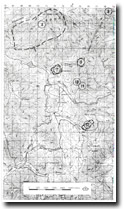8423-6 to 14 The Upper Bindi Area
|
This information has been developed from the publications:
|
| Introduction: | Recent mineral discoveries north of Bindi have heightened interest in the geology of this area, and more detailed mapping has been undertaken by the Geological Survey of Victoria. The important stratigraphic units of this area include: a) The Thorkidaan Volcanics which are thought to be Middle Silurian in age. This group was until recently included in the Snowy River Volcanics but has been shown to have a distinctive lithology and to be separated from the latter by an unconformity. The type section for the Thorkidaan Volcanic Group is a series of road cuttings on Limestone Road between Limestone Creek and Native Dog Plain (Sites 8524-2, 8423-8, 8423-9). b) The Enano Group, which are Upper Silurian in age and include volcanics and marine sediments. The latter facies distinguish this group from the Thorkidaan Volcanics. The Enano Group is a new name to replace the previously used Cowombat Group. The Enano Group has been subdivided into four formations; i) The Bumble Creek Andesite (Site 8524-1) ii) The Gibsons Folly Formation (Site 8424-13) iii) The Cowombat Siltstone (previously Cowombat Formation) (Site 8524-3) iv) The Tawonga Sandstone (previously the Towanga Formation) (Site 8523-1, 8523-4) c) The Snowy River Volcanics, a series of acid volcanics with interbedded sediments of Middle-Early Devonian age which predominate between the Buchan and Snowy Rivers and which outcrop in the Bindi north area (Site 8423-9). d) The Buchan Group of late Early Devonian age includes two formations in this area: i) The Buchan Caves Limestone (Sites 8423-10, 8423-12) ii) The Taravale Formation (Site 8423-13) e) The Mt Tambo Group, which is thought to be of Middle or Late Devonian age, occupies a graben north of Bindi and consists of coarse grained clastic sediments and rare acid volcanics (Sites 8423-6, 8423-7). | |
Location: | 719038. 12 kilometres north of Bindi. | |
Abstract: | Exposures of Mt Tambo Group. | |
Access: | Walk from Mt Tambo Group. | |
Ownership: | Crown land. | |
Geology: | Abundant outcrops of the Mt Tambo Group conglomerates and interbedded coarse sandstone occur on Mt Tambo and to the south of the mountain. The conglomerates are commonly clast-supported, the clasts consisting predominantly of sub-rounded to rounded quartzites and reef quartz with minor clasts of granite, red siltstone, sandstone and slate. Lenses and interbeds of sandstone occur with the conglomerates and these are generally poorly sorted and consist of sub-rounded granules of sandstone, siltstone, slate and quartzite in a subordinate silty matrix. Finer sediment types occur to the east of Mt Tambo. These include sandstone and siltstones with minor conglomeratic and rhyolitic interbeds. The Mt Tambo Group conglomerates are faulted against Ordovician schists to the east of Mt Tambo and intruded by The Sisters porphyry to the west. Contact metamorphism producing minor hornfels occurs close to this contact. | |
Geomorphology: | Several fossil localities, are recorded on the northern slopes of Mt Tambo. These occur in yellowish and bluish micaceous shale and consist of narrow plant stems and “strap-like” leaves with a single indeterminate fish plate. All the fossil remains are poorly preserved and are not useful for age determinations. | |
Significance: | Regional. This sequence of sediments and volcanics is distinctive to the region and is of importance as the age of the group is still uncertain. It has been variously suggested as Silurian, Middle to Late Devonian and Late Devonian. | |
Management: | Because of the area covered by the site the value of the significant geological features is unlikely to be seriously reduced by localized disturbance e.g. road works or extractive industry. | |
References: | Crohn, P.W. 1950. 'The geology, petrology and physiography of the Omeo District, North-Eastern Victoria', Proc. R. Soc. Vict., 62 :1-70 Lew, J.H. 1979. The geology of North Bindi. Honours Thesis, (unpub.) Department of Geology, Monash University. Vandenberg, A.M.H., Bolger, P., and O’Shea, P.J. 1980. (in press) 'Geology and Mineral Exploration of the Limestone Creek-Reedy Creek Area, North-East Victoria', Geolo. Surv. Vict. | |



